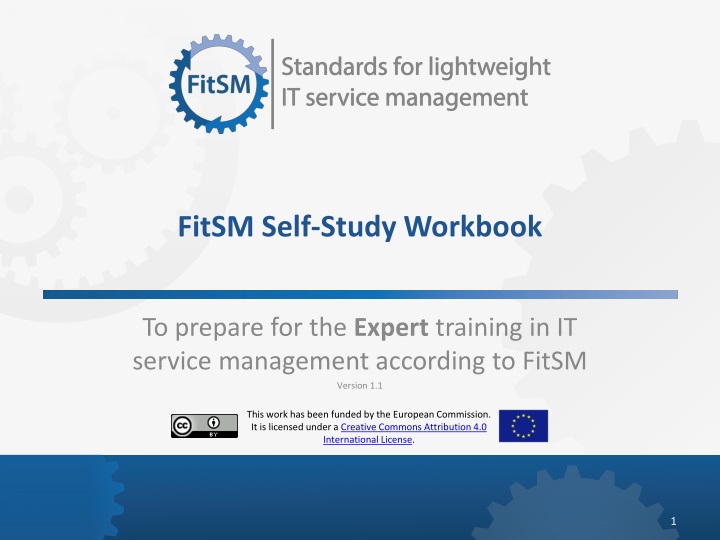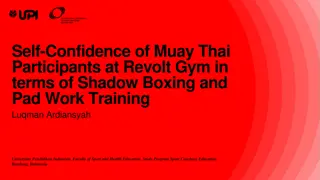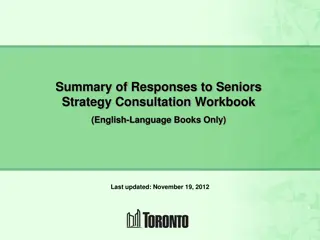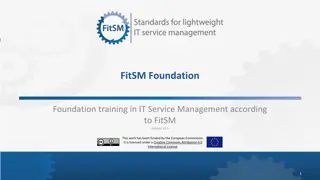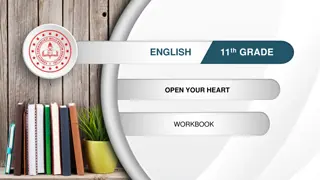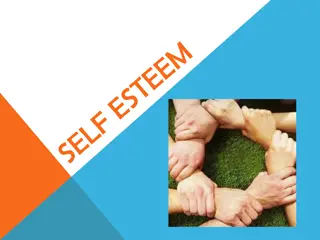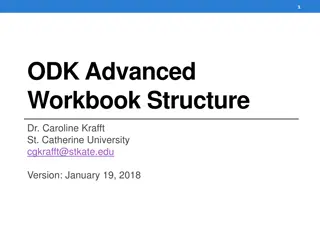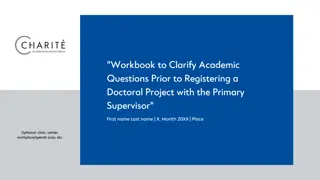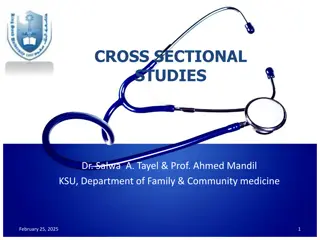FitSM Self-Study Workbook for Expert Training in IT Service Management
Dive into the FitSM self-study workbook funded by the European Commission to prepare for expert-level training in IT service management. Explore key terms, definitions, and structured content covering FitSM parts and related standards. Enhance your knowledge with comprehensive guidance on service planning, delivery, operation, and control in the IT sector.
Download Presentation

Please find below an Image/Link to download the presentation.
The content on the website is provided AS IS for your information and personal use only. It may not be sold, licensed, or shared on other websites without obtaining consent from the author.If you encounter any issues during the download, it is possible that the publisher has removed the file from their server.
You are allowed to download the files provided on this website for personal or commercial use, subject to the condition that they are used lawfully. All files are the property of their respective owners.
The content on the website is provided AS IS for your information and personal use only. It may not be sold, licensed, or shared on other websites without obtaining consent from the author.
E N D
Presentation Transcript
FitSM Self-Study Workbook To prepare for the Expert trainingin IT service management according to FitSM Version 1.1 This work has been funded by the European Commission. It is licensed under a Creative Commons Attribution 4.0 International License. 1
FitSM qualification program Expert Level Expert training in IT service management 2 days Self-study workbook Advanced Level 2 days 2 days Advanced training in service planning and delivery Advanced training in service operation and control Foundation Level Foundation training in IT service management 1 day 2
How this workbook is structured FitSM parts Key terms and definitions Service management systems FitSM-1: Requirements ITSM processes according to FitSM: Mixed topics FitSM-3: Generic roles in ITSM Related standards and frameworks ca. 150 min 3
FitSM parts Terminology FitSM-0 (0) Requirements FitSM-1 (1) FitSM-2 (2) FitSM-3 (3) Questions / Assignments Support & Guidance FitSM-4 FitSM-5 FitSM-6 (6) Selected (4) Selected (5) 4
Key terms & definitions Definition following FitSM-0: (1) Entirety of activities performed by an IT service provider to plan, deliver, operate and control IT services offered to customers Definition following FitSM-0: (2) Entirety of policies, processes, procedures and related resources and capabilities aiming at effectively performing management tasks in a given context and for a given subject Questions / Assignments Definition following FitSM-0: (3) Overall management system that controls and supports management of services within an organisation or federation 5
Key terms & definitions Definition following FitSM-0: (4) : Documented set of intentions, expectations, goals, rules and requirements, often formally expressed by top management representatives in an organisation or federation Definition following FitSM-0: (5) : Structured set of activities, with clearly defined responsibilities, that bring about a specific objective or set of results from a set of defined inputs Questions / Assignments Definition following FitSM-0: (6) : Set of actions carried out within a process 6
Key terms & definitions Definition following FitSM-0: (7) : Specified set of steps or instructions to be carried out by an individual or team to perform one or more activities of a process Definition following FitSM-0: (8) : Set of responsibilities and connected behaviours or actions collected into a logical unit that can be assigned to an individual or group Questions / Assignments 7
Service management systems (1) level Top management SMS owner Process owners Policy 1. Abc def ghijk. 2. Abc def ghijk. 3. Abc def ghijk. 4. Abc def ghijk. e.g. Incident handling policy, change policy, security policy (2) level Process managers Process teams Inputs (4) : Activities and roles e.g. incident management, change management, security management, Outputs Questions / Assignments (3) level Departments Functions Process staff Proce- dures Person (in a role) e.g. procedures for classifying and prioritizing incidents applies 8
FitSM-1: Requirements (1/2) Overall, FitSM-1 defines 85 requirements that should be fulfilled by an organisation (or federation) offering IT services to customers. Compliance with the 85 requirements can be regarded as a proof of effectiveness . The 85 requirements are structured as follows: 16 general requirements grouped in seven topic areas (GR1 to GR7) 69 process-specific requirements grouped in 14 processes (PR1 to PR14) Questions / Assignments 9
FitSM-1: Requirements (2/2) Overall, FitSM-1 defines 85 requirements that should be fulfilled by an organisation (or federation) offering IT services to customers. Compliance with the 85 requirements can be regarded as a proof of effectiveness . The 85 requirements are structured as follows: 16 general requirements grouped in seven topic areas (GR1 to GR7) 69 process-specific requirements grouped in 14 processes (PR1 to PR14) Questions / Assignments 10
ITSM processes according to FitSM: (?) : Inputs & outputs Inputs Outputs Customer demand and requirements A complete and up-to-date (1) Understanding of the service provider s resources and capabilities Valid and consistent service descriptions / specifications Questions / Assignments (2) for new or changed services Understanding of the service provider s limitations and constraints 11
ITSM processes according to FitSM: (?) : Inputs & outputs Inputs Outputs Defined service portfolio Up-to-date (1) General and specific customer requirements Default / corporate level SLA Individual SLAs with customers Questions / Assignments Supporting (2) and (3) 12
ITSM processes according to FitSM: SACM: Ongoing process activities Identify and record service availability and continuity (1) Assess (2) related to service availability and continuity Maintain service availability and continuity (3) Perform service continuity (4) (5) service availability and continuity Questions / Assignments 13
ITSM processes according to FitSM: ISM: Critical success factors An up-to-date (1) inventory is available and reviewed regularly. Information security (2) are identified and assessed. Technical, physical and organisational / administrative (3) to mitigate information security risks are effectively implemented and continually (4) and improved. Information security (5) are avoided effectively. If an information security incident occurred, it is identified as such and handled in an effective way. Questions / Assignments 14
ITSM processes according to FitSM: ISRM: Workflow of process activities Incident (1) (2) (4) (3) Yes Functional escalation required? Analyze Questions / Assignments No (5) Close 15
ITSM processes according to FitSM: CHM: Workflow of process activities (1) Filter Register Classify No Change refused Approved? (2) & Approve Yes Questions / Assignments Release & Deployment Management (3) (4) 16
ITSM processes according to FitSM: Overview of key process interfaces SLAs (1) CONFM (4) Configuration information ISRM Service request records Incident records Change records Change schedule (2) CHM Questions / Assignments Problem records RDM PM Release records (5) (3) 17
FitSM-3: Generic roles in ITSM (1/2) 1. SMS owner 2. SMS manager 3. Process owner 4. Process manager 5. Case owner 6. Member of process staff 7. Service owner Questions / Assignments 18
FitSM-3: Generic roles in ITSM (2/2) 1. SMS owner 2. SMS manager 3. Process owner 4. Process manager 5. Case owner 6. Member of process staff 7. Service owner Questions / Assignments 19
Related standards and frameworks ISO 9000 ISO/IEC 20000 ISO/IEC 27000 Legend IT service management standard / framework FitSM ITIL Quality management standard Questions / Assignments Information security management standard COBIT Software engineering maturity model CMMI ISO 15504 adoption of concepts 20
